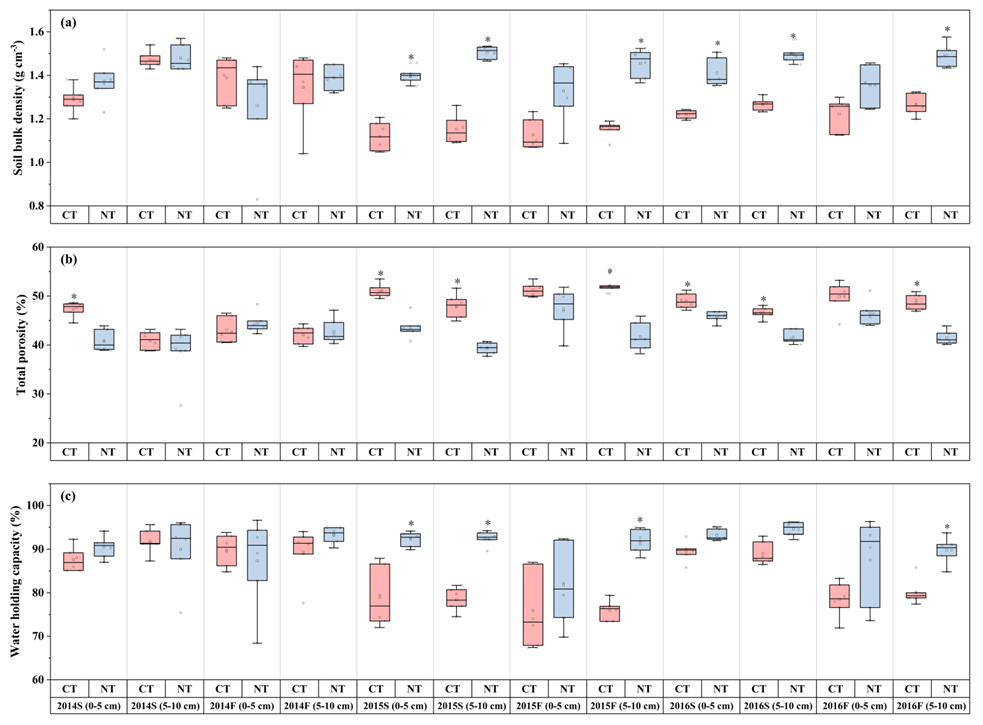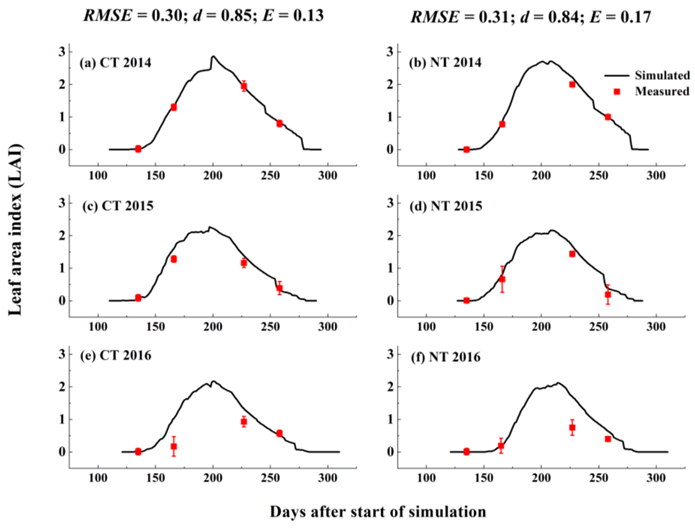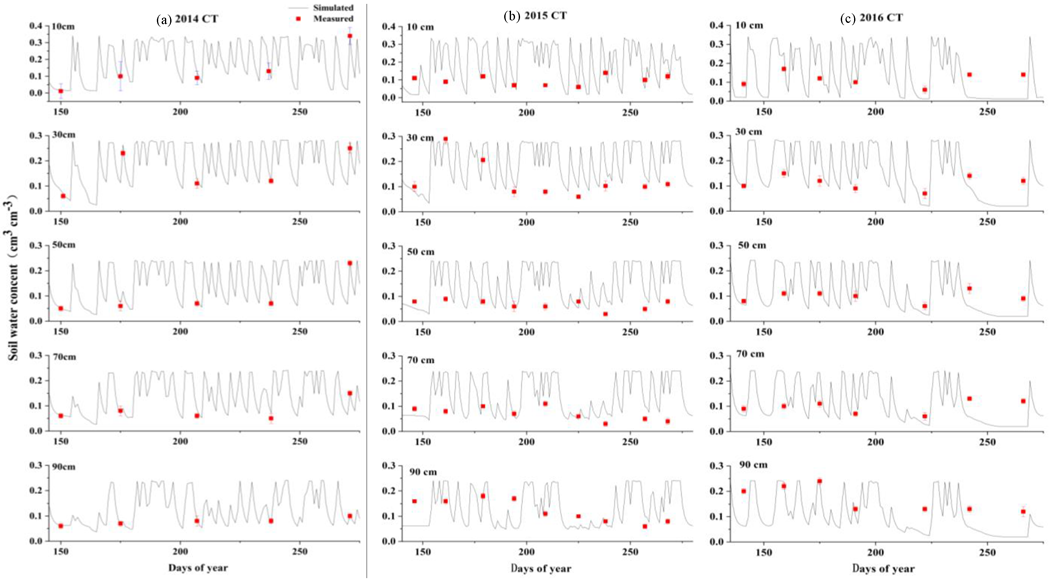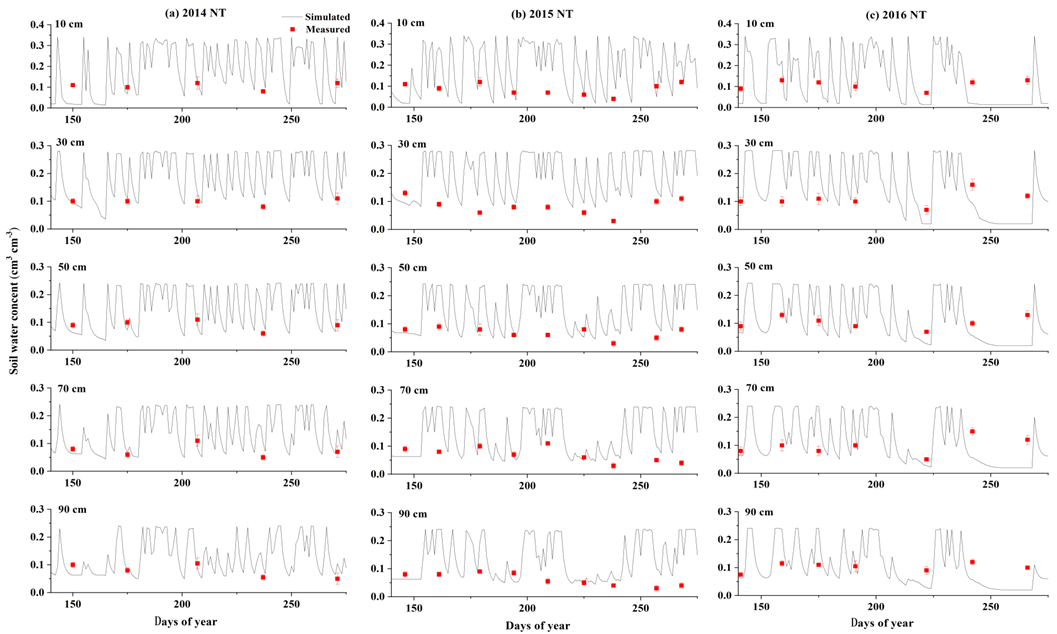Effects of Conventional Tillage and No-Tillage Systems on Maize (Zea mays L.) Growth and Yield, Soil Structure, and Water in Loess Plateau of China: Field Experiment and Modeling Studies
Abstract
:1. Introduction
2. Materials and Methods
2.1. Site Description and Experimental Design
2.2. Field Experiment and Management
2.3. Sampling, Measurements, and Analyses
2.4. Model Inputs
2.4.1. Weather and Soil Profile Data
2.4.2. Crop Growth and Cultivar Parameters
2.5. Model Statistics Criteria
3. Results and Discussion
3.1. Field Experiment
3.1.1. Soil Physical Properties
3.1.2. Maize Yields and Leaf Area Index
3.1.3. Soil Water Content Variations
3.2. Model Calibration and Evaluation
3.2.1. Maize Yields and Leaf Area Index
3.2.2. Soil Water Content
3.3. Model Application
3.3.1. Evapotranspiration
3.3.2. Correlations between Crop Production and Water Conditions
4. Conclusions
Supplementary Materials
Author Contributions
Funding
Data Availability Statement
Conflicts of Interest
References
- Deepak, T.S.; Jayadeep, P.A. Prospects of maize (corn) wet milling by-products as a source of functional food ingredients and nutraceuticals. Food Technol. Biotechnol. 2022, 60, 109–120. [Google Scholar] [CrossRef] [PubMed]
- Dabija, A.; Ciocan, M.E.; Chetrariu, A.; Codină, G.G. Maize and sorghum as raw materials for brewing, a review. Appl. Sci. 2021, 11, 3139. [Google Scholar] [CrossRef]
- Lobulu, J.; Shimelis, H.; Laing, M.; Mushongi, A.A. Maize production constraints, traits preference and current striga control options in western Tanzania: Farmers’ consultation and implications for breeding. Acta Agric. Scand. B Soil Plant Sci. 2019, 69, 734–746. [Google Scholar] [CrossRef]
- Zhang, D.; Li, D.; Li, H.; Wang, H.; Liu, J.; Ju, H.; Batchelor, W.D.; Li, R.; Li, Y. Strategies to reduce crop water footprint in intensive wheat-maize rotations in North China Plain. Agronomy 2022, 12, 357. [Google Scholar] [CrossRef]
- Liu, S.; Zhang, X.Y.; Yang, J.Y.; Drury, C.F. Effect of conservation tillage on soil physical properties, water storage and water use efficiency in Northeast China. Acta Agric. Scand. B Soil Plant Sci. 2013, 63, 383–394. [Google Scholar] [CrossRef]
- Gan, Y.; Campbell, C.A.; Liu, L.; Basnyat, P.; McDonald, C.L. Water use and distribution profile under pulse and oilseed crops in semiarid northern high latitude areas. Agric. Water Manag. 2009, 96, 337–348. [Google Scholar] [CrossRef]
- Endale, D.M.; Cabrera, M.L.; Steiner, J.L.; Radcliffe, D.E.; Vencill, W.K.; Schomberg, H.H.; Lohr, L. Impact of conservation tillage and nutrient management on soil water and yield of cotton fertilized with poultry litter or ammonium nitrate in the Georgia Piedmont. Soil Tillage Res. 2002, 66, 55–68. [Google Scholar] [CrossRef]
- Drury, C.F.; Reynolds, W.D.; Welacky, T.W.; Weaver, S.E.; Hamill, A.S.; Vyn, T.J. Impacts of zone tillage and red clover on corn performance and soil physical quality. Soil Sci. Soc. Am. J. 2003, 67, 867–877. [Google Scholar] [CrossRef]
- Drury, C.F.; Reynolds, W.D.; Yang, X.M.; McLaughlin, N.B.; Welacky, T.W.; Weaver, C.W.; Grant, C.A. Nitrogen source, application time, and tillage effects on soil nitrous oxide emission and corn grain yields. Soil Sci. Soc. Am. J. 2011, 76, 1268–1279. [Google Scholar] [CrossRef]
- Gruber, S.; Pekrun, C.; Mohring, J.; Claupein, W. Long-term yield and weed response to conservation and stubble tillage in SW Germany. Soil Tillage Res. 2012, 121, 49–56. [Google Scholar] [CrossRef]
- Drury, C.F.; Tan, C.S.; Welacky, T.W.; Oloya, T.O.; Hamill, A.S.; Weaver, S.E. Red clover and tillage influence on soil temperature, water content, and corn emergence. Agron. J. 1999, 91, 101–108. [Google Scholar] [CrossRef]
- Puustinen, M.; Koskiaho, J.; Peltonen, K. Influence of cultivation methods on suspended solids and phosphorus concentrations in surface runoff on clayey sloped fields in boreal climate. Agric. Ecosyst. Environ. 2005, 105, 565–579. [Google Scholar] [CrossRef]
- Dahiya, R.; Ingwersen, J.; Streck, T. The effect of mulching and tillage on the water and temperature regimes of a loess soil: Experimental findings and modeling. Soil Tillage Res. 2007, 96, 52–63. [Google Scholar] [CrossRef]
- Sharma, P.; Abrol, V.; Sharma, R.K. Impact of tillage and mulch management on economics, energy requirement and crop performance in maize-wheat rotation in rainfed subhumid inceptisols, India. Eur. J. Agron. 2011, 34, 46–51. [Google Scholar] [CrossRef]
- Moussa-Machraoui, S.B.; Errouissi, F.; Ben-Hammouda, M.; Nouira, S. Comparative effects of conventional and no-tillage management on some soil properties under mediterranean semi-arid conditions in northwestern Tunisia. Soil Tillage Res. 2010, 106, 247–253. [Google Scholar] [CrossRef]
- Soane, B.D.; Ball, B.C.; Arvidsson, J.; Basch, G.; Moreno, F.; Roger-Estrade, J. No-till in northern, western and south-western Europe: A review of problems and opportunities for crop production and the environment. Soil Tillage Res. 2012, 118, 66–87. [Google Scholar] [CrossRef] [Green Version]
- He, J.; Wang, Q.J.; Li, H.W.; Liu, L.J.; Gao, H.W. Effect of alternative tillage and residue cover on yield and water use efficiency in annual double cropping system in North China plain. Soil Tillage Res. 2009, 104, 198–205. [Google Scholar] [CrossRef]
- Chen, Z.; Cui, H.; Wu, P.; Zhao, Y.; Sun, Y. Study on the optimal intercropping width to control wind erosion in North China. Soil Tillage Res. 2010, 110, 230–235. [Google Scholar] [CrossRef]
- Wang, X.; Dai, K.; Zhang, D.; Zhang, X.; Wang, Y.; Zhao, Q.; Cai, D.; Hoogmoed, W.B.; Oenema, O. Dryland maize yields and water use efficiency in response to tillage/crop stubble and nutrient management practices in China. Field Crop Res. 2011, 120, 47–57. [Google Scholar] [CrossRef]
- Jin, Y.H.; Zhou, D.W.; Jiang, S.C. Comparison of soil water content and corn yield in furrow and conventional ridge sown systems in a semiarid region of China. Agric. Water Manag. 2010, 97, 326–332. [Google Scholar] [CrossRef]
- Prasuhn, V. On-farm effects of tillage and crops on soil erosion measured over 10 years in Switzerland. Soil Tillage Res. 2012, 120, 137–146. [Google Scholar] [CrossRef]
- DeLaune, P.B.; Sij, J.W. Impact of tillage on runoff in long term no-till wheat systems. Soil Tillage Res. 2012, 124, 32–35. [Google Scholar] [CrossRef]
- Su, Z.Y.; Zhang, J.S.; Wu, W.L.; Cai, D.X.; Lv, J.J.; Jiang, G.H.; Huang, J.; Gao, J.; Hartmann, R.; Gabriels, D. Effects of conservation tillage practices on winter wheat water-use efficiency and crop yield on the loess plateau, China. Agric. Water Manag. 2007, 87, 307–314. [Google Scholar] [CrossRef]
- Khaledian, M.R.; Mailhol, J.C.; Ruelle, P.; Rosique, P. Adapting pilote model for water and yield management under direct deeding system: The case of corn and durum wheat in a Mediterranean context. Agric. Water Manag. 2009, 96, 757–770. [Google Scholar] [CrossRef] [Green Version]
- Liu, S.; Yang, J.Y.; Zhang, X.Y.; Drury, C.F.; Reynolds, W.D.; Hoogenboom, G. Modelling crop yield, soil water content and soil temperature for a soybean-maize rotation under conventional and conservation tillage systems in Northeast China. Agric. Water Manag. 2013, 123, 32–44. [Google Scholar] [CrossRef]
- Brisson, N.; Gary, C.; Justes, E.; Roche, R.; Mary, B.; Ripoche, D.; Zimmer, D.; Sierra, J.; Bertuzzi, P.; Burger, P.; et al. An overview of the crop model STICS. Eur. J. Agron. 2003, 18, 309–332. [Google Scholar] [CrossRef]
- Flerchinger, G.N.; Hardegree, S.P. Modelling near-surface soil temperature and moisture for germination response predictions of post-wildfire seedbeds. J. Arid Environ. 2004, 59, 369–385. [Google Scholar] [CrossRef]
- Kool, J.B.; Van Genuchten, M.T. HYDRUS, One-Dimensional Variably Saturated Flow and Transport Model, Including Hysteresis and Root Water Uptake, Version 3.2; User Manual; Hydrogeologic Inc.: Herndon, VA, USA, 1989. [Google Scholar]
- Flerchinger, G.N.; Sauer, T.J.; Aiken, R.A. Effects of crop residue cover and architecture on heat and water transfer at the soil surface. Geoderma 2003, 116, 217–233. [Google Scholar] [CrossRef]
- Mailhol, J.C.; Olufayo, A.A.; Ruelle, P. Sorghum and sunflower evapotranspiration and yield from simulated leaf area index. Agric. Water Manag. 1997, 35, 167–182. [Google Scholar] [CrossRef]
- Jansson, P.E.; Moonb, D.S. A coupled model of water, heat and mass transfer using object orientation to improve flexibility and functionality. Environ. Modell Softw. 2001, 16, 37–46. [Google Scholar] [CrossRef]
- Ma, L.W.; Trout, T.J.; Ahuja, L.R.; Bausch, W.C.; Saseendran, S.A.; Malone, R.W.; Nielsen, D.C. Calibrating rzwqm2 model for maize responses to deficit irrigation. Agric. Water Manag. 2012, 103, 140–149. [Google Scholar] [CrossRef]
- Williams, J.R. The Erosion-Productivity Impact Calculator (EPIC) Model: A Case History; USDA ARS: Beltsville, MD, USA, 1990; pp. 421–427. [Google Scholar]
- Williams, J.R. The EPIC model. In Computer Models of Watershed Hydrology; Singh, V.P., Ed.; Water Resources Publisher: Highlands Ranch, CO, USA, 1995; pp. 909–1000. [Google Scholar]
- Jones, J.W.; Hoogenboom, G.; Porter, C.H.; Boote, K.J.; Batchelor, W.D.; Hunt, L.A.; Wilkens, P.W.; Singh, U.; Gijsman, A.J.; Ritchie, J.T. The DSSAT cropping system model. Eur. J. Agron. 2003, 18, 235–265. [Google Scholar] [CrossRef]
- Knörzer, H.; Grözinger, H.; Graeff-Hönninger, S.; Hartung, K.; Piepho, H.P.; Claupein, W. Integrating a simple shading algorithm into Ceres-wheat and Ceres-maize with particular regard to a changing microclimate within a relayintercropping system. Field Crop Res. 2011, 121, 274–285. [Google Scholar] [CrossRef]
- Gijsman, A.J.; Hoogenboom, G.; Parton, W.J.; Kerridge, P.C. Modifying DSSAT crop models for low-input agricultural systems using a soil organic matterresidue module from CENTURY. Agron. J. 2002, 94, 462–474. [Google Scholar] [CrossRef]
- IUSS Working Group WRB. World Reference Base for Soil Resources 2014, Update 2015: International Soil Classification System for Naming Soils and Creating Legends for Soil Maps; World Soil Resources Reports No. 106; FAO: Rome, Italy, 2015. [Google Scholar]
- Liang, H.B.; Xue, Y.R.; Shi, J.W.; Li, Z.S.; Liu, G.H.; Fu, B.J. Soil moisture dynamics under Caragana korshinskii shrubs of different ages in Wuzhai County on the Loess Plateau, China. Earth Environ. Sci. Trans. R. Soc. Edinb. 2019, 109, 387–396. [Google Scholar] [CrossRef]
- Jiang, X.J.; Liu, S.; Zhang, H. Effects of different management practices on vertical soil water flow patterns in the Loess Plateau. Soil Tillage Res. 2017, 166, 33–42. [Google Scholar] [CrossRef]
- Evett, S.R. Gravimetric and volumetric direct measurements of soil water content. In Field Estimation of Soil Water Content: A Practical Guide to Methods, Instrumentation, and Sensor Technology. IAEA-TCS-30; Evett, S.R., Heng, L.K., Moutonnet, P., Nguyen, M.L., Eds.; International Atomic Energy Agency: Vienna, Austria, 2008; pp. 23–24. [Google Scholar]
- Wilkens, P.W. Chaper 4-DSSAT v4 Weather Data Editing Program (WeatherMan). In Decision Support System for Agrotechnology Transfer Version 4.0; Hoogenboom, G., Jones, J.W., Porter, C.H., Wilkens, P.W., Boote, K.J., Batchelor, W.D., Hunt, L.A., Tsuji, G.Y., Eds.; DSSAT v4: Data Management and Analysis Tools; University of Hawaii: Honolulu, HI, USA, 2004; Volume 2. [Google Scholar]
- Yang, J.Y.; Huffman, E.C. Easygrapher: Software for graphical and statistical validation of dssat outputs. Comput. Electron. Agric. 2004, 45, 125–132. [Google Scholar] [CrossRef]
- Boote, K.J.; Jones, J.W.; Hoogenboom, G. Simulation of crop growth: CROPGRO model. In Agricultural Systems Modeling and Simulation; Peart, R.M., Curry, R.B., Eds.; Marcel Dekker: New York, NY, USA, 1998; pp. 1–42. [Google Scholar]
- Fabrizzi, K.P.; García, F.O.; Costa, J.L.; Picone, L.I. Soil water dynamics, physical properties and corn and wheat responses to minimum and no-tillage systems in the southern Pampas of Argentina. Soil Tillage Res. 2005, 81, 57–69. [Google Scholar] [CrossRef]
- Hou, X.; Li, R.; Jia, Z.; Han, Q.; Wang, W.; Yang, B. Effects of rotational tillage practices on soil properties, winter wheat yields and water-use efficiency in semi-arid areas of north-west China. Field Crop Res. 2012, 129, 7–13. [Google Scholar] [CrossRef]
- Franzluebbers, A.J.; Schomberg, H.H.; Endale, D.M. Surface-soil responses to paraplowing of long-term no-tillage cropland in the Southern Piedmont USA. Soil Tillage Res. 2007, 96, 303–315. [Google Scholar] [CrossRef]
- Glab, T.; Kulig, B. Effect of mulch and tillage system on soil porosity under wheat (Triticum aestivum). Soil Tillage Res. 2008, 99, 169–178. [Google Scholar] [CrossRef]
- Alvarez, R.; Steinbach, H.S. A review of the effects of tillage systems on some soil physical properties, water content, nitrate availability and crops yield in the Argentine Pampas. Soil Tillage Res. 2009, 104, 1–15. [Google Scholar] [CrossRef]
- Van den Putte, A.; Govers, G.; Diels, J.; Gillijns, K.; Demuzere, M. Assessing the effect of soil tillage on crop growth: A meta-regression analysis on european crop yields under conservation agriculture. Europ. J. Agron. 2010, 33, 231–241. [Google Scholar] [CrossRef]
- Verhulst, N.; Govaerts, B.; Nelissen, V.; Sayre, K.D.; Crossa, J.; Raes, D.; Deckers, J. The effect of tillage, crop rotation and residue management on maize and wheat growth and development evaluated with an optical sensor. Field Crop Res. 2011, 120, 58–67. [Google Scholar] [CrossRef]
- Schwartz, R.C.; Baumhardt, R.L.; Evett, S.R. Tillage effects on soil water redistribution and bare soil evaporation throughout a season. Soil Tillage Res. 2010, 110, 221–229. [Google Scholar] [CrossRef]
- Cullum, R.F. Influence of tillage on maize yield in soil with shallow fragipan. Soil Tillage Res. 2012, 119, 1–6. [Google Scholar] [CrossRef]
- Monzon, J.P.; Sadras, V.O.; Andrade, F.H. Modelled yield and water use efficiency of maize in response to crop management and Southern Oscillation Index in a soil-climate transect in Argentina. Field Crop Res. 2012, 130, 8–18. [Google Scholar] [CrossRef]
- Liu, H.L.; Yang, J.Y.; Drury, C.F.; Reynolds, W.D.; Tan, C.S.; Bai, Y.L.; He, P.; Jin, J.; Hoogenboom, G. Using the DSSAT-CERES-Maize model to simulate crop yield and nitrogen cycling in fields under long-term continuous maize production. Nutr. Cycl. Agroecosyst. 2011, 89, 313–328. [Google Scholar] [CrossRef]







| Soil Depth | Bulk Density | Field Capacity | Wilting Point | Saturated Water Content | Silt Content | Clay Content | Organic Carbon Content | pH |
|---|---|---|---|---|---|---|---|---|
| (cm) | (g cm−3) | (cm3 cm−3 ) | (cm3 cm−3 ) | (cm3 cm−3 ) | (%) | (%) | (%) | |
| 0‒10 | 1.10 | 0.385 | 0.115 | 0.440 | 12.99 | 1.90 | 0.47 | 9.44 |
| 10‒20 | 1.19 | 0.333 | 0.140 | 0.372 | 15.11 | 2.05 | 0.36 | 9.42 |
| 20‒30 | 1.38 | 0.193 | 0.138 | 0.209 | 8.48 | 1.33 | 0.36 | 9.56 |
| 30‒40 | 1.39 | 0.241 | 0.128 | 0.252 | 7.92 | 1.14 | 0.37 | 9.38 |
| 40‒50 | 1.50 | 0.240 | 0.153 | 0.246 | 6.49 | 0.41 | 0.37 | 9.36 |
| 50‒70 | 1.55 | 0.220 | 0.136 | 0.225 | 5.09 | 0.42 | 0.31 | 9.33 |
| 70‒90 | 1.57 | 0.201 | 0.130 | 0.211 | 3.16 | 0.56 | 0.26 | 9.30 |
| 90‒110 | 1.58 | 0.198 | 0.146 | 0.200 | 1.99 | 0.85 | 0.21 | 9.20 |
| Maize Cultivar Parameter | Range | Default Cultivar | Calibrated Cultivar |
|---|---|---|---|
| P1: Time from seedling emergence to the end of juvenile phase during which the plant is not responsive to photoperiod (degree day > 8 °C) | 100‒400 | 220.8 | 230.8 |
| P2: Extent to which development (expressed as days) is delayed for each hour increase in photoperiod > the longest photoperiod 12.5 h) | 0‒4.0 | 2.55 | 2.9 |
| P5: Thermal time from silking to physiological maturity (degree day > 8 °C) | 600‒900 | 842.8 | 842.8 |
| G2: Maximum possible number of kernels per plant | 380‒1000 | 898.8 | 950.1 |
| G3: Kernel growth rate during the linear grain filling stage under optimum conditions (mg d−1) | 5‒12 | 6.952 | 7.529 |
| PHINT: Phyllochron interval between successive leaf tip appearances (degree day per tip) | 38.9‒55.0 | 38.9 | 38.9 |
| Growth Stage | CWAD | EPAA | SWTD | GWAD | |
|---|---|---|---|---|---|
| CWAD | 1.000 | ||||
| Seeding | EPAA | 0.784 ** | 1.000 | ||
| SWTD | −0.198 ** | −0.237 ** | 1.000 | ||
| CWAD | 1.000 | ||||
| Jointing | EPAA | 0.332 ** | 1.000 | ||
| SWTD | 0.087 | −0.092 | 1.000 | ||
| CWAD | 1.000 | ||||
| Tasseling | EPAA | 0.035 | 1.000 | ||
| SWTD | 0.138 * | −0.219 ** | 1.000 | ||
| CWAD | 1.000 | ||||
| Harvesting | EPAA | −0.396 ** | 1.000 | ||
| SWTD | 0.149 ** | 0.100 | 1.000 | ||
| GWAD | 0.019 ** | −0.679 ** | −0.003 | 1.000 |
Publisher’s Note: MDPI stays neutral with regard to jurisdictional claims in published maps and institutional affiliations. |
© 2022 by the authors. Licensee MDPI, Basel, Switzerland. This article is an open access article distributed under the terms and conditions of the Creative Commons Attribution (CC BY) license (https://creativecommons.org/licenses/by/4.0/).
Share and Cite
Liu, S.; Gao, Y.; Lang, H.; Liu, Y.; Zhang, H. Effects of Conventional Tillage and No-Tillage Systems on Maize (Zea mays L.) Growth and Yield, Soil Structure, and Water in Loess Plateau of China: Field Experiment and Modeling Studies. Land 2022, 11, 1881. https://doi.org/10.3390/land11111881
Liu S, Gao Y, Lang H, Liu Y, Zhang H. Effects of Conventional Tillage and No-Tillage Systems on Maize (Zea mays L.) Growth and Yield, Soil Structure, and Water in Loess Plateau of China: Field Experiment and Modeling Studies. Land. 2022; 11(11):1881. https://doi.org/10.3390/land11111881
Chicago/Turabian StyleLiu, Shuang, Yuru Gao, Huilin Lang, Yong Liu, and Hong Zhang. 2022. "Effects of Conventional Tillage and No-Tillage Systems on Maize (Zea mays L.) Growth and Yield, Soil Structure, and Water in Loess Plateau of China: Field Experiment and Modeling Studies" Land 11, no. 11: 1881. https://doi.org/10.3390/land11111881
APA StyleLiu, S., Gao, Y., Lang, H., Liu, Y., & Zhang, H. (2022). Effects of Conventional Tillage and No-Tillage Systems on Maize (Zea mays L.) Growth and Yield, Soil Structure, and Water in Loess Plateau of China: Field Experiment and Modeling Studies. Land, 11(11), 1881. https://doi.org/10.3390/land11111881







